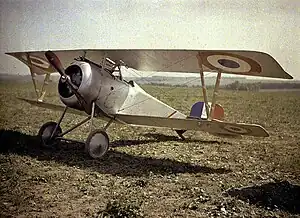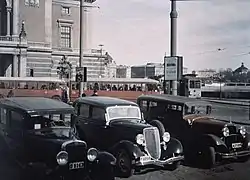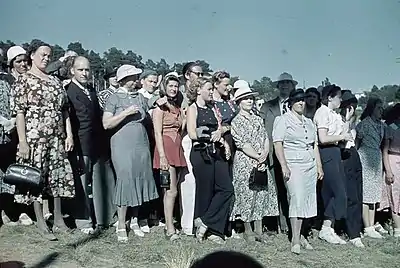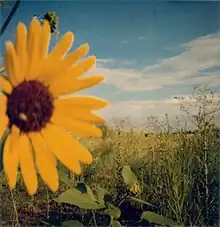
Color photography is a type of photography that uses media capable of capturing and reproducing colors. By contrast, black-and-white or gray-monochrome photography records only a single channel of luminance (brightness) and uses media capable only of showing shades of gray.
Technique
In color photography, electronic sensors or light-sensitive chemicals record color information at the time of exposure. This is usually done by analyzing the spectrum of colors into three channels of information, one dominated by red, another by green and the third by blue, in imitation of the way the normal human eye senses color. The recorded information is then used to reproduce the original colors by mixing various proportions of red, green and blue light (RGB color, used by video displays, digital projectors and some historical photographic processes), or by using dyes or pigments to remove various proportions of the red, green and blue which are present in white light (CMY color, used for prints on paper and transparencies on film).
Colorization
Monochrome images which have been "colorized" by tinting selected areas by hand or mechanically or with the aid of a computer are "colored photographs", not "color photographs". Their colors are not dependent on the actual colors of the objects photographed and may be inaccurate.
The foundation of all practical color processes, the three-color method was first suggested in an 1855 paper by Scottish physicist James Clerk Maxwell, with the first color photograph produced by Thomas Sutton for a Maxwell lecture in 1861.[1][2] Color photography has been the dominant form of photography since the 1970s, with monochrome photography mostly relegated to niche markets such as art photography.
History
Three-color processes

The three-color method, which is the foundation of most practical color processes, whether chemical or electronic, was first suggested in an 1855 paper on color vision by Scottish physicist James Clerk Maxwell.[1][2]
In his studies of color vision, Maxwell showed, by using a rotating disk with which he could alter the proportions of visible hue, or gray tone. This could be made by mixing only three pure colors of light – red, green, and blue – in proportions that would stimulate the three types of cells to the same degrees under particular lighting conditions.[3] Each type of cell by itself did not actually see color but was stimulated. He drew an analogy to black-and-white photography: if three colorless photographs of the same scene were taken through red, green and blue filters, and transparencies ("slides") made from them were projected through the same filters and superimposed on a screen. This would result in a image reproducing not only red, green and blue, but all of the colors in the original scene.[4]
The first color photograph made according to this method, a set of three monochrome "color separations", was taken by Thomas Sutton in 1861 for use in illustrating a lecture on color by Maxwell, where it was shown in color by the triple projection method.[5] The test subject was a bow made of ribbon with stripes of various colors, including red and green. During the lecture about physics and physiology, not photography, Maxwell commented on the inadequacy of the results and the need for a photographic material more sensitive to red and green light. A century later, historians were mystified by the reproduction of any red at all because the photographic process used by Sutton was, for all practical purposes, insensitive to red light and only marginally sensitive to green. In 1961, researchers found that many red dyes also reflect ultraviolet light, coincidentally transmitted by Sutton's red filter, and surmised that the three images were probably due to ultra-violet, blue-green, and blue wavelengths, rather than to red, green, and blue.[6]
Screen-plate era

The Joly screen process emerged as a simpler and cheaper alternative, requiring no specialized camera or viewer. Instead, it necessitated a unique color-compensating filter for the camera lens and a particular holder for the photographic plates. The core of the system resided within the holder: a clear glass plate meticulously ruled with fine lines of three colors, creating a, repeating pattern across its entire surface. Rather than capturing three separate photographs through individual colored filters, this method employed narrow strips (the colored lines) to allow the essential color information to be recorded in a single, composite image. After developing the negative, a positive transparency was produced, and a viewing screen—with red, green, and blue lines matching the taking screen's pattern—was precisely aligned and applied, rendering the colors visible. The transparency and screen were notably similar to the monochrome liquid crystal elements and overlay of ultra-thin red, green, and blue color filter stripes that generate the color image in a typical LCD display. This invention was attributed to Irish scientist John Joly, who, like many inventors, discovered that the fundamental concept had been preemptively outlined in Louis Ducos du Hauron's 1868 patent, which had since expired.[7]
 A 1908 Autochrome Lumière photograph of American author Mark Twain.
A 1908 Autochrome Lumière photograph of American author Mark Twain. A 1914 color photograph of the Taj Mahal published in a 1921 issue of National Geographic magazine.
A 1914 color photograph of the Taj Mahal published in a 1921 issue of National Geographic magazine.
 A 1917 Autochrome color photograph of a French Army lookout at his observation post during World War I.
A 1917 Autochrome color photograph of a French Army lookout at his observation post during World War I. House in Stockholm, Autochrome, 1930.
House in Stockholm, Autochrome, 1930. Autochrome dated 1934, the Royal Swedish Opera
Autochrome dated 1934, the Royal Swedish Opera
 Agfacolor photo dated 1937, World exposition in Paris, France
Agfacolor photo dated 1937, World exposition in Paris, France An Agfacolor slide dated 1937 from café in Oslo, Norway.
An Agfacolor slide dated 1937 from café in Oslo, Norway. An Agfacolor slide dated 1938 from Sweden.
An Agfacolor slide dated 1938 from Sweden. Agfacolor photo dated 1938, Vaxholm in Sweden
Agfacolor photo dated 1938, Vaxholm in Sweden Kodachrome photo taken at the 1939 New York World's Fair
Kodachrome photo taken at the 1939 New York World's Fair Kodachrome photo by Chalmers Butterfield of Shaftesbury Avenue from Piccadilly Circus, in the West End of London, c. 1949
Kodachrome photo by Chalmers Butterfield of Shaftesbury Avenue from Piccadilly Circus, in the West End of London, c. 1949 John Canoe Festival celebrants, Kingston, Jamaica, Christmas 1975 (digitized from Kodachrome original)
John Canoe Festival celebrants, Kingston, Jamaica, Christmas 1975 (digitized from Kodachrome original) A sample shot of Polaroid Type 600, ISO 640, color film, 2009
A sample shot of Polaroid Type 600, ISO 640, color film, 2009
Digital photography
While digital photography has only relatively recently become mainstream, the late 20th century saw many small developments leading to its creation. The history of digital photography began in the 1950s. In 1951, the first digital signals were saved to magnetic tape via the first video tape recorder.[8] Six years later, in 1957, the first digital image was produced through a computer by Russell Kirsch. It was an image of his son.[9]

The first semiconductor image sensor was the charge-coupled device (CCD), invented by physicists Willard S. Boyle and George E. Smith at Bell Labs in 1969.[10] While researching the metal-oxide semiconductor (MOS) process, they realized that an electric charge was analogous to a magnetic bubble and that the charge could be stored on a tiny MOS capacitor. As it was fairly straightforward to fabricate a series of MOS capacitors in a row, they connected a suitable voltage to the capacitors so that the charge could be stepped along from one to the next.[11] This semiconductor circuit was later used in the first digital video cameras for television broadcasting,[12] and its invention was recognized by a Nobel Prize in Physics in 2009.[13]
The first close-up image of Mars was taken as Mariner 4 flew by it on July 15, 1965, with a digital camera system designed by NASA and JPL. In 1976, the twin Mars Viking Landers produced the first images from the surface of Mars. The imaging process was different from that of a modern digital camera, though the result was similar; Viking used a mechanically scanned facsimile camera rather than a mosaic of solid state sensor elements.[14] This produced a digital image that was stored on tape for later, relatively slow transmission back to Earth.[15][16]
The first published color digital photograph was produced in 1972 by Michael Francis Tompsett using CCD sensor technology and was featured on the cover of Electronics Magazine. It was a picture of his wife, Margaret Tompsett.[17] The Cromemco Cyclops, a digital camera developed as a commercial product and interfaced to a microcomputer, was featured in the February 1975 issue of Popular Electronics magazine. It used MOS technology for its image sensor.
An important development in digital image compression technology was the discrete cosine transform (DCT), a lossy compression technique first proposed by Nasir Ahmed while he was working at the Kansas State University in 1972.[18] DCT compression is used in the JPEG image standard, which was introduced by the Joint Photographic Experts Group in 1992.[19] JPEG compresses images down to much smaller file sizes, and has become the most widely used image file format.[20] The JPEG standard was largely responsible for popularizing digital photography.[21]
The first self-contained (portable) digital camera was created in 1975 by Steven Sasson of Eastman Kodak.[22][23] Sasson's camera used CCD image sensor chips developed by Fairchild Semiconductor in 1973.[24] The camera weighed 8 pounds (3.6 kg), recorded black-and-white images to a cassette tape, had a resolution of 0.01 megapixels (10,000 pixels), and took 23 seconds to capture its first image in December 1975. The prototype camera was a technical exercise, not intended for production.[25] While it was not until 1981 that the first consumer camera was produced by Sony, the groundwork for digital imaging and photography had been laid.[26]
The first digital single-lens reflex (DSLR) camera was the Nikon SVC prototype demonstrated in 1986, followed by the commercial Nikon QV-1000C released in 1988.[27] The first widely commercially available digital camera was the 1990 Dycam Model 1; it also sold as the Logitech Fotoman. It used a CCD image sensor, stored pictures digitally, and connected directly to a computer for downloading images.[28][29][30] Originally offered to professional photographers for a hefty price, by the mid-to-late 1990s, due to technology advancements, digital cameras were commonly available to the general public.
The advent of digital photography also gave way to cultural changes in the field of photography. Unlike film photography, dark rooms and hazardous chemicals were no longer required for the post-production of an image – images could now be processed and enhanced from a personal computer. This allowed photographers to be more creative with their processing and editing techniques. As the field became more popular, digital photography and photographers diversified. Digital photography expanded the field of photography from a small, somewhat elite circle to one that encompassed many people.[31]
The camera phone further helped popularize digital photography, along with the Internet, social media,[32] and the JPEG image format.[21] The first cell phones with built-in digital cameras were produced in 2000 by Sharp and Samsung.[33] Small, convenient, and easy to use, camera phones have made digital photography ubiquitous in the daily life of the general public.
Artists' perspectives
Photographers differed in opinion about color photography when it was introduced. Some fully embraced it when it was available to the public in the late 1930s. While others remained skeptical of its relevance in photography.
Proponents
Paul Outerbridge was an American photographer prominent for his early use and experiments in color photography. He began writing a monthly column on color photography for the U.S. Camera Magazine around 1930. Outerbridge became known for the high quality of his color illustrations, made by a highly complex tri-color carbro process.[34] In 1940 he published his seminal book Photographing in Color, using high quality illustrations to explain his techniques.[35]
Ferenc Berko, a photographer who lived during the introduction of color film, recognized a potential of color film. He saw it as a way to experiment with the subjects he photographed and how he conveyed emotion in the photograph.[36]
John Hedgecoe, another photographer who lived during the time period, was another example of those who adopted color photographs. He published a book entitled The Art of Color Photography, which explained the importance of understanding the
Special and often subtle relationships between different colors.
— John Hedgecoe
He also described the psychological and emotional power of color on the viewer since certain colors, he argues, can make people feel a certain way.[37]
Skeptics
Harold Baquet, for instance—a photographer who lived during the 1980's, known best for documenting New Orleans civil rights—was not keen on color. He preferred to take pictures mainly using black-and-white film. When asked about his reasoning for this preference during an interview, he replied,
The less is more. Sometimes the color distracts from the essential subject. Sometimes, light, line, and form is enough, allowing you to explore the sculptural qualities of that third dimension, that illusional dimension of depth. And it’s fun.
— Harold Baquet
This aversion to color was due mainly to a fear of losing simplicity in his pictures. He worried that color gave the eye too much to take in.[38]
See also
- People
- Other topics
- Color motion picture film
- Color printing
- Color television
- Film colorization
- Hand-coloring (easily mistaken for early color photography)
- List of color film systems
- List of early color feature films
- List of photographs considered the most important
- Photochrome
- Photographic processes
- Potassium ferricyanide
- The Shackleton Expedition, on which Paget color photography was used (among other types)
- Timeline of historic inventions
References
- 1 2 "1861: James Clerk Maxwell's greatest year". King's College London. 3 January 2017. Archived from the original on 4 January 2017. Retrieved 3 January 2017.
- 1 2 "From Charles Mackintosh's waterproof to Dolly the sheep: 43 innovations Scotland has given the world". The independent. 30 December 2016. Archived from the original on 2 October 2017. Retrieved 5 May 2023.
- ↑ Maxwell, James Clerk (1855). "Experiments on colour, as perceived by the eye, with remarks on colour-blindness". Transactions of the Royal Society of Edinburgh. XXI part II. Archived from the original on 2014-07-14. Retrieved 2014-07-06.
- ↑ Science progress in the twentieth century: a quarterly journal of scientific work & thought, Volume 2. John Murray. 1908. p. 359. Archived from the original on 2019-12-15. Retrieved 2016-10-10. (Note: in apparent deference to the primaries named by Thomas Young, Maxwell calls the short-wavelength primary "violet" in the relevant paragraphs of his 1855 paper, though he used blue in his experiments, which the paper also describes, and in his 1861 demonstration)
- ↑ "The first colour photograph, 1861". The Guardian. 3 January 2017. Archived from the original on 4 January 2017. Retrieved 3 January 2017.
- ↑ R.W.G. Hunt (2004). The Reproduction of Colour, 6th edition. Wiley. pp 9–10.
R.M. Evans (1961a). “Some Notes on Maxwell’s Colour Photograph.” Journal of Photographic Science 9. pp243–246
R.M. Evans (1961b). “Maxwell's Color Photography”. Scientific Photography 205. pp 117–128. - ↑ Joly, J: "On a method of photography in natural colors," Scientific Transactions of the Royal Dublin Society, October 1896, 6(2):127–138. This source provides details, such as the specific reasons for the unusual colors used in the taking screen and examples of the required exposures. The color illustrations underwent significant handwork by the engravers and may have been entirely hand-colored, using the original transparencies as a guide. As noted on page 127, publication was delayed by more than a year. The 1895 date is confirmed by the publication of a lengthy abstract in Nature, November 28, 1895, 53(1361):91–93.
- ↑ Nuwer, Rachel. "The Inventor of Videotape Recorders Didn't Live to See Blockbuster's Fall". Smithsonian. Archived from the original on 2020-10-25. Retrieved 2017-11-19.
- ↑ Hernandez, Paul (2007-05-24). "Fiftieth Anniversary of First Digital Image Marked". NIST. Archived from the original on 2017-09-29. Retrieved 2017-11-19.
- ↑ James R. Janesick (2001). Scientific charge-coupled devices. SPIE Press. pp. 3–4. ISBN 978-0-8194-3698-6.
- ↑ Williams, J. B. (2017). The Electronics Revolution: Inventing the Future. Springer. pp. 245–8. ISBN 9783319490885.
- ↑ Boyle, William S; Smith, George E. (1970). "Charge Coupled Semiconductor Devices". Bell Syst. Tech. J. 49 (4): 587–593. doi:10.1002/j.1538-7305.1970.tb01790.x.
- ↑ "The 2009 Nobel Prize in Physics - Press Release". www.nobelprize.org. Archived from the original on 2018-09-23. Retrieved 2017-11-19.
- ↑ Mutch, Thomas (1978). The Martian Landscape. NASA. ISBN 1782664882.
- ↑ Fred C. Billingsley, "Processing Ranger and Mariner Photography," in Computerized Imaging Techniques, Proceedings of SPIE, Vol. 0010, pp. XV-1–19, January 1967 (August 1965, San Francisco). "Mariner is unique in that the pictures were converted to the 6-bit digital form in the spacecraft. The digital signals were transmitted at a very slow rate (8 1/3 bits/sec) and decoded and reformatted in the 7094 computer before being presented to the film recording equipment on computer tape. Thus, there are no digitizing and synchronizing problems, and the operation consists merely of producing the digitally recorded film."
- ↑ "Mariner to Mercury, Venus, and Mars" (PDF). NASA Facts. Archived from the original (PDF) on 15 February 2017. Retrieved 2 August 2012.
- ↑ Ghosh, Pallab (1 February 2017). "Digital imaging wins engineering prize". BBC News. Archived from the original on 27 March 2018. Retrieved 27 March 2018.
- ↑ Ahmed, Nasir (January 1991). "How I Came Up With the Discrete Cosine Transform". Digital Signal Processing. 1 (1): 4–5. doi:10.1016/1051-2004(91)90086-Z. Archived from the original on 2016-06-10. Retrieved 2019-09-14.
- ↑ "T.81 – DIGITAL COMPRESSION AND CODING OF CONTINUOUS-TONE STILL IMAGES – REQUIREMENTS AND GUIDELINES" (PDF). CCITT. September 1992. Archived (PDF) from the original on 30 December 2019. Retrieved 12 July 2019.
- ↑ "The JPEG image format explained". BT.com. BT Group. 31 May 2018. Archived from the original on 5 August 2019. Retrieved 5 August 2019.
- 1 2 "What Is a JPEG? The Invisible Object You See Every Day". The Atlantic. 24 September 2013. Archived from the original on 9 October 2019. Retrieved 13 September 2019.
- ↑ "Digital Photography Milestones from Kodak". Women in Photography International. Archived from the original on 28 December 2009. Retrieved 17 September 2007.
- ↑ "Kodak blog: We Had No Idea". Archived from the original on 21 January 2013.
- ↑ Michael R. Peres (2007). The Focal Encyclopedia of Photography (4th ed.). Focal Press. ISBN 978-0-240-80740-9.
- ↑ Estrin, James (12 August 2015). "Kodak's First Digital Moment". Lens Blog. Archived from the original on 2017-12-01. Retrieved 2017-11-19.
- ↑ "History". The Digital Camera Museum. Archived from the original on 2021-01-28. Retrieved 2017-11-19.
- ↑ Busch, David D. (2011). Nikon D70 Digital Field Guide. John Wiley & Sons. ISBN 9781118080238.
- ↑ "1990". DigiCam History Dot Com. Archived from the original on 26 June 2010. Retrieved 17 September 2007.
- ↑ "Dycam Model 1: The world's first consumer digital still camera". DigiBarn computer museum. Archived from the original on 2010-10-17. Retrieved 2012-02-22.
- ↑ Carolyn Said, "DYCAM Model 1: The first portable Digital Still Camera", MacWeek, vol. 4, No. 35, 16 Oct. 1990, p. 34.
- ↑ Lister, Martin (2013). The Photographic Image in Digital Culture. Routledge. p. 86. ISBN 978-0415535298.
- ↑ Lee, Dong-Hoo (2010). "Digital Cameras, Personal Photography and the Reconfiguration of Spatial Experiences". The Information Society. 26 (4): 266–275. doi:10.1080/01972243.2010.489854. S2CID 1661237.
- ↑ "From J-Phone to Lumia 1020: A complete history of the camera phone". digitaltrends.com. 11 August 2013. Archived from the original on 14 September 2019. Retrieved 27 March 2018.
- ↑ Szarkowski, John (July 28, 1999). Looking at Photographs: 100 Pictures from the Collection of the Museum of Modern Art. Bulfinch.
- ↑ "When Color Was Vulgar: Paul Outerbridge's Avant-Gardist's Eye". The New Yorker. 5 August 2016. Archived from the original on 2018-09-21. Retrieved 2019-08-12.
- ↑ Honan, William (March 26, 2000). "Ferenc Berko, 84, Pioneer In Use of Color Photography". The New York Times. Archived from the original on March 4, 2016. Retrieved February 18, 2017.
- ↑ Hedgecoe, John (1998). The Art of Color Photography. Reed Consumer Books.
- ↑ Tuley, Laura Camille (December 2007). "An Interview with Harold Baquet" (PDF). New Orleans Review. 33 (2): 108–116. Archived (PDF) from the original on July 17, 2018. Retrieved March 21, 2012.
General references
- Coe, Brian (1978). Colour Photography: the first hundred years 1840–1940. Ash & Grant.
- Coote, Jack (1993). The Illustrated History of Colour Photography. Fountain Press Ltd., ISBN 0-86343-380-4.
- Preservation of Photographs. Kodak publication, no. F-30. (1979). Rochester, NY: Eastman Kodak Co.
- Paine, C. (1996). Standards in the Museum Care of Photographic Collections. London, UK: Museums & Galleries Commission. ISBN 0-948630-42-6.
- Keefe, L.E.; & Inch, D. (1990). The Life of a Photograph: Archival processing, matting, framing, storage. Boston, MA: Focal Press. ISBN 0-240-80024-9, ISBN 978-0-240-80024-0.
- Lavédrine, B.; Gandolfo, J.-P.; Monod, S. (2003). A Guide to the Preventive Conservation of Photograph Collections. Los Angeles, CA: Getty Conservation Institute. ISBN 0-89236-701-6, ISBN 978-0-89236-701-6.
- Photograph Preservation and the Research Library. (1991). Mountain View, CA: The Research Libraries Group. ISBN 0-87985-212-7.
- Penichon, Sylvie (2013). Twentieth-Century Color Photographs: Identification and Care. Los Angeles, CA: Getty Publications. ISBN 978-1-60606-156-5.
- Reilly, J.M.; et al. (1998). Storage Guide for Color Photographic Materials. Albany, NY: University of the State of New York.
- Ritzenthaler, M.L.; Vogt-O'Connor, D. (2006). Photographs: Archival care and management. Chicago, IL: Society of American Archivists. ISBN 1-931666-17-2, ISBN 978-1-931666-17-6.
- Sipley, Louis Walton. (1951). A Half Century of Color, New York, NY: Macmillan.
- Caring for Photographs: Display, storage, restoration. Life library of photography. (1982). Alexandria, VA: Time-Life Books. ISBN 0-8094-4420-8.
- Weinstein, R.A.; Booth, L. (1977). Collection, Use, and Care of Historical Photographs. Nashville, TN: American Association for State and Local History. ISBN 0-910050-21-X.
- Wilhelm, H.G.; Brower, C. (1993). The Permanence and Care of Color Photographs: Traditional and digital color prints, color negatives, slides, and motion pictures. Grinnell, IA: Preservation Pub. Co. ISBN 0-911515-00-3.
- Wythe, D. (2004). Museum Archives: An introduction. Chicago, IL: Society of American Archivists. ISBN 1-931666-06-7, ISBN 978-1-931666-06-0.
Further reading
- Mathew Carey Lea in 1887 article appearing in Scientific American entitled "Photography in Natural Colors".[1]
- Rogers, David (October 2007), The Chemistry of Photography: From Classical to Digital Technologies, Royal Society of Chemistry, ISBN 9780854042739, OCLC 1184188382
- ↑ Scientific American. Munn & Company. 1887-07-09. p. 17.
